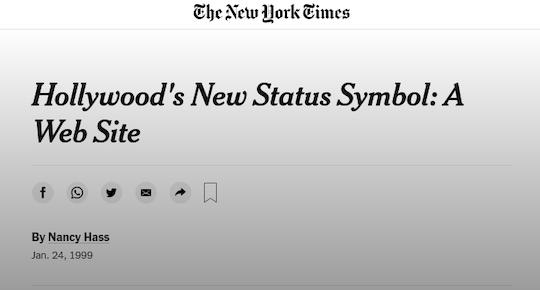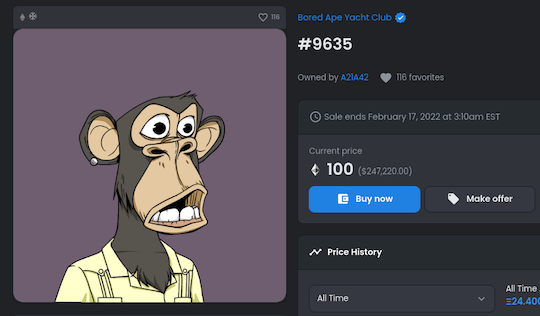How to Fake a Bored Ape
Posted January 28, 2022
Chris Campbell
I just received this question about NFTs and thought I’d take a stab at it.
So I have a question. Someone generates an NFT, say of a bored ape in yachting attire, and sells it for a six-figure sum. The proud owner now gets to use it and own it.
But what is to keep someone from taking that image, changing one pixel, such that the human eye can discern no difference, and selling that near-clone as another NFT?
And then repeating the process 100 times or more? True the original is still just that, but the others are so similar as to be indistinguishable. Would that not tend to devalue the original? I'm new to all this, and not inclined to invest, but I do like to learn.
Thanks for the question.
The short answer is that when you buy an NFT, you’re not really buying the digital image. Sounds crazy, given that’s the whole idea, but it’s true. Instead, you’re buying a single token that acts as proof of ownership of that particular digital image.
Without the authentic token, you don’t own anything. And there’s only one of those tokens in existence -- hence why it’s “non-fungible.”
Because it’s stored on the blockchain, this token is provably unique. No more tokens can and will be created.
You could try to forge the token by creating your own, but it would be too easy to verify that it’s a forgery. Why? Because it can’t be traced back to the original creator’s address.
(This is a crucial point. I’ll explain further in a moment.)
In short, if you know what you’re doing, these tokens are very easy to verify.
But I know what you’re thinking…
OK. So what about the image?
This actually catches a lot of people off guard. If all you’re buying is a token, what does it have to do with the image?
Well, here’s how it works.
Inside the token’s metadata is the information about the proper image attached to the token. This metadata doesn’t change, so ideally the image shouldn’t change either.
(Usually, the image is stored in a decentralized manner through a file-sharing system called “IPFS,” but sometimes the image is actually stored on the blockchain. A few projects are in the works to store large image files permanently on the web, just like data is stored on the blockchain.)
So let’s say you still want to own one of those “bored apes in yacht attire.”
What is the Bored Ape Yacht Club?
Bored Ape Yacht Club is a collection of 10,000 ape NFTs. Each NFT is its own digital token on the Ethereum blockchain.
Bored Apes are desirable because… human nature. It is currently one the most exclusive online clubs in the world. Your favorite actor either has a Bored Ape already or is considering it.
In 1999, Hollywood’s status symbol was a personal website.

Before that it was a star on the Hollywood Walk of Fame.
Today, in 2022, if you want to make millions of strangers jealous… buy a Bored Ape.
Each ape has its own Token ID, ranging from 1 to 10,000.

The easiest way to purchase this NFT is to go to the largest NFT marketplace called Opensea.
On Opensea, you log in with your personal crypto wallet (using a browser plugin called Metamask).
Your Ethereum address, where you store your crypto, is your “account number.”
From your wallet, assuming you have enough Ethereum, you can purchase a Bored Ape. You send the Ethereum and you get back Bored Ape token #9635.
Everyone will be able to verify that you own it because the token will be in your wallet.
But how do you verify the token is authentic before you buy it?
On Opensea, you’ll find the details of each NFT, along with the “Contract Address” and the “Token ID.”

Each NFT project on the Ethereum blockchain has its own Contract Address. This is the original creator’s wallet address.
Here’s the original address for Bored Ape Yacht Club:
0xBC4CA0EdA7647A8aB7C2061c2E118A18a936f13D
If the NFT didn’t come from this wallet address originally, it isn’t a real Bored Ape.
You verify it’s real on a “blockchain explorer” called “etherscan.”
Here’s the etherscan link for ape #9635.
On this page, among other things, you can see who currently owns the token. This will help you verify that you’re buying the authentic NFT.
OK. This might seem silly. I know.
Especially since Bored Ape #9635 is selling for a whopping $247,220.

But Don’t Count NFTs Out Just Yet…
NFTs are useful beyond digital art.
NFTs are digital property rights in a distributed network. They allow you specific access rights within a network that can’t be taken away arbitrarily.
The most obvious use-case in the near-term is ticketing. All major events will use NFTs in the near future.
Expect some kind of “Ticketmaster for NFTs” to appear, probably sooner than later, and disrupt Ticketmaster.
NFTs are also a way to prove digital ownership of anything without the need for a centralized authority.
(In fact, one of our favorite Early Stage Crypto Investor recommendations allows for digital animators (think: Pixar) to retain control and rights over their work in an unforgeable way — filling a major need in the animation industry. And that’s just one game-changing thing their software has accomplished.)
Ultimately, NFTs can go even further. They can change the way we build businesses, raise money, fund creative projects, and much more.
In fact, we’re currently looking at a few more paradigm-shifting projects for our Early Stage Crypto Investor subscribers.
If you’re interested in getting ahead of the NFT curve…
Click here to see if ESC is right for you.
Chris Campbell
For Altucher Confidential
